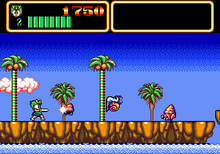Wonder Boy III: Monster Lair
| Wonder Boy III: Monster Lair | |
|---|---|
 Promotional brochure for the arcade version | |
| Developer(s) | Westone Bit Entertainment |
| Publisher(s) |
|
| Composer(s) | Shinichi Sakamoto |
| Platform(s) | Arcade, CD-ROM²/TurboGrafx-CD, Mega Drive, Wii (Virtual Console), Microsoft Windows (Steam) |
| Release | Arcade
|
| Genre(s) | Scrolling shooter |
| Mode(s) | Single player, multiplayer |
| Arcade system | Sega System 16 |
Wonder Boy III: Monster Lair (ワンダーボーイIII モンスターレア, Wandā Bōi Surī: Monsutā Reā, "Wonder Boy III Monster Lair") is a side-scrolling action game developed by Westone Bit Entertainment that was originally released for the arcades by Sega in 1988. It is the third game in the Wonder Boy series and the last one released for the arcade. A console adaptation was made by Hudson Soft, released in 1989 in Japan for the PC Engine CD-ROM² System and the subsequent North American release on the TurboGrafx-CD dropped the 'Wonder Boy III' title. It was also converted and released by Sega for the Mega Drive in Japan in 1990 and Europe in 1991. Both, the TurboGrafx-CD and Mega Drive versions have been re-released for the Wii Virtual Console.
Gameplay[edit]

The game balances basic concepts found in both platformers and arcade shooters. The player is able to jump and shoot projectiles from a sword. He must ride a flying dragon and confront a large boss throughout the second half of each round. The player's life bar steadily diminishes as time passes. Health is gained through collection of fruit and projectile weapons. Some fruits, when shot, will expand and burst into multiple items.
Combat[edit]
In the action scenes, the player's vitality decreases as he makes his way towards the skull, but this can be restored by collecting fruit. A wide variety of weapons can be picked up, and not only do these allow the player to use the weapons for a limited amount of time, but they also increase vitality. In the shooter scenes, the player rides a pink friend as he makes his way through the scene. Here, vitality remains static unless hit by an enemy passing by. As usual, there is a boss waiting at the end that must be defeated. Every boss changes color to show how much damage has been done to it. Some bosses must be defeated in two stages. If vitality gets low in each scene, the player loses a life. Two players can play the game simultaneously.
Plot and setting[edit]
The player controls a green-haired boy hero named Leo (player 1) or a pink-haired girl hero named Princess Purapril (Priscilla in the English language versions, player 2) who must attack the invaders that attempt to collect weapons and use them to destroy the land. The gameplay consists of action and shooter scenes. The game starts out as a simple platform game, and later on the game is transformed into a shoot 'em up.
Development[edit]
The game's music was composed by Shinichi Sakamoto, who is also responsible for the music of the game Wonder Boy in Monster Land.
Reception[edit]
In Japan, Game Machine listed Wonder Boy III: Monster Lair on their December 15, 1988 issue as being the seventh most-successful table arcade unit of the month.[4]
References[edit]
- ^ "Wonder Boy III: Monster Lair". Arcade-History. Archived from the original on 2012-07-28. Retrieved 2013-02-26.
- ^ "Monster Lair arcade flyer". Retrieved 2019-09-04.
- ^ "It's Crystal Clear: Mario, Magic and Monsters – Oh My!". Nintendo of America. 2009-04-20. Archived from the original on 2009-04-21. Retrieved 2009-04-21.
- ^ "Game Machine's Best Hit Games 25 - テーブル型TVゲーム機 (Table Videos)". Game Machine (in Japanese). No. 346. Amusement Press, Inc. 15 December 1988. p. 25.
External links[edit]
- 1988 video games
- Arcade video games
- Cooperative video games
- Sega Genesis games
- TurboGrafx-CD games
- Virtual Console games
- Wonder Boy (video game series)
- Side-scrolling platformers
- Windows games
- Video game sequels
- Video games developed in Japan
- Video games featuring female protagonists
- Video games scored by Jun Chikuma
- Multiplayer and single-player video games
- Scrolling shooters
- Run and gun games
- Westone Bit Entertainment games
